Samsung Galaxy Note 20 Ultra review: Unabashedly over the top
It's only worth it if you need the best of the best... and an S Pen.
When I first spent time with the Galaxy Note 20 Ultra, I said it felt a lot like a Galaxy S20 Ultra "with a stylus and a bit of a makeover." I also said that, with devices like that super-premium S20 Ultra kicking around, the Note 20 Ultra didn’t feel distinct or even necessary.
It's time to eat some crow. What didn't come across during that brief socially distanced demo was that, by curbing some of its wilder initiatives and dutifully improving existing features, Samsung built its best big phone ever. Sorry, S20 Ultra: This thing is faster, sleeker, more technically impressive and even a little less expensive. You never stood a chance. What people should keep in mind, though, is that we live in an age where powerful smartphones are getting cheaper, and cheaper smartphones are getting better. Since that (very good) trend seems unlikely to change, the Note 20 Ultra is only worth the splurge if you need the best of the best... and the S Pen.
Key specs
Samsung Galaxy S20 Ultra | |
Processor | Octa-core Snapdragon 865 Plus |
RAM/storage | 12GB+128/512GB |
MicroSD card support | Yes, up to 1TB |
Main display | 6.9-inch Dynamic AMOLED 2X display |
Display resolution | 1440 x 3088 (21:9) |
Rear cameras | 108MP f/1.8 wide camera with OIS, 12MP f/2.2 ultra-wide camera (120° field of view), 12MP f/3.0 telephoto camera with 5x optical zoom, laser autofocus |
Front-facing camera | 10MP f/2.2 camera |
OS | Android 10 with One UI 2.0 |
Battery | 4,500mAh |
Charging | USB-C, supports fast wireless charging |
Dimensions | 164.8x77.2x8.1mm |
Weight | 208g |
Fingerprint sensor | Yes, in-display |
Waterproofing | Yes, rated IP68 |
NFC | Yes |
Headphone jack | No |
5G support | Yes, sub-6 and mmWave |
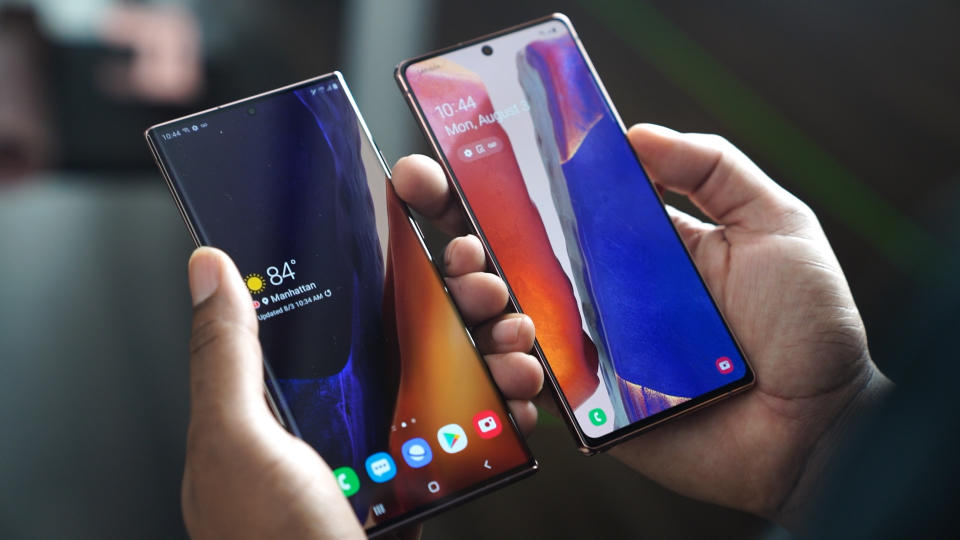
Configurations
When the Galaxy Note 20 Ultra goes on sale on August 21st, you'll have two versions to choose from. The base model comes with 128GB of internal storage and costs $1,300 — that's $100 less than the similarly spec'd S20 Ultra. If you need even more space to play with, the 512GB variant will set you back $1,450. (Bear in mind, both accept microSD cards as large as 1TB.) Your next choice is color: The Note 20 Ultra is available in black, white and bronze.
Samsung will also sell a pared-down version — simply the Note 20 — for a more “reasonable” $1,000. We haven't been able to test one thoroughly, but the company had to make some notable compromises to drive its price down. That might make sense for some people, but most die-hard Note fans will want an Ultra instead.
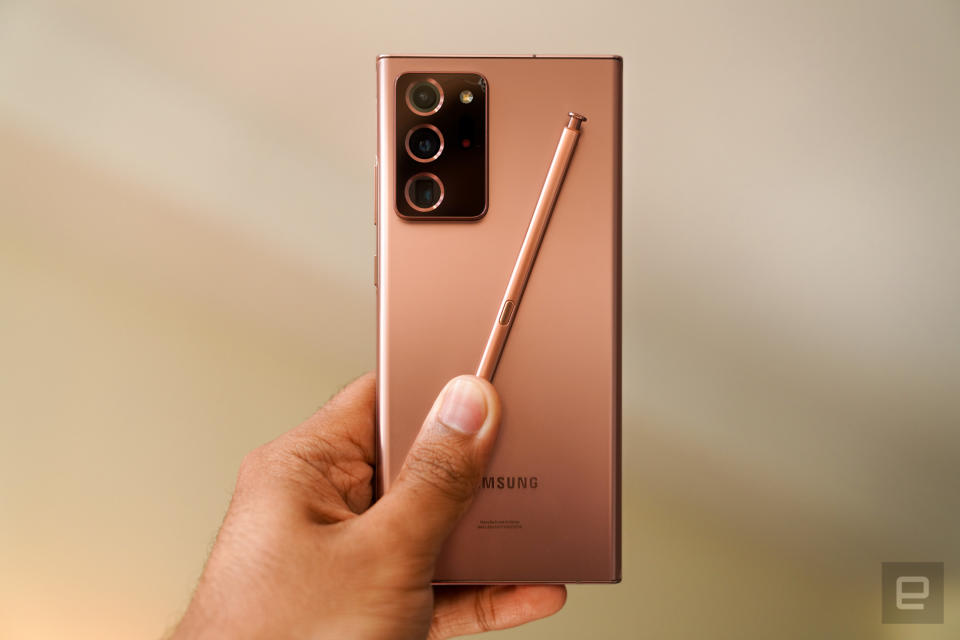
Design and display
I used to be obsessed with big phones, but after spending some time with the iPhone SE and the Pixel 4a, I'm over them. These days we have to find comfort where we can, and the idea of one-handing an enormous slab of glass and metal doesn't have the appeal it used to. I mention this because, on paper, the Note 20 Ultra sounds big enough to make my wrist twinge in pained anticipation.
Thankfully, the Note 20 Ultra feels a lot more manageable than I would’ve expected. For one, it isn't as chonky as the S20 Ultra; Samsung shaved a few meaningful fractions of a millimeter off the Note's waistline. At 208 grams (or 7.34 ounces), the Note 20 Ultra is slightly lighter than the S20 Ultra too. The difference roughly equals the weight of two nickels, but believe me when I say every gram counts in a device you unlock dozens of times a day. And to top it off, the Note 20 Ultra's nearly bezel-less Dynamic AMOLED 2X display has a 21:9 aspect ratio, which means this 6.9-inch screen is more than twice as tall as it is wide. That’s enough to make the Note 20 Ultra almost surprisingly easy to grip.
That'll be little consolation to people who prefer small devices, though, since Samsung screwed them this year. See, last August, the company released its first-ever “small” Galaxy Note, giving folks who can't palm basketballs a chance to experience life with the S Pen. Rather than keep that promising trend going, though this year's standard Note 20 is just a fraction of an inch smaller than the Ultra.
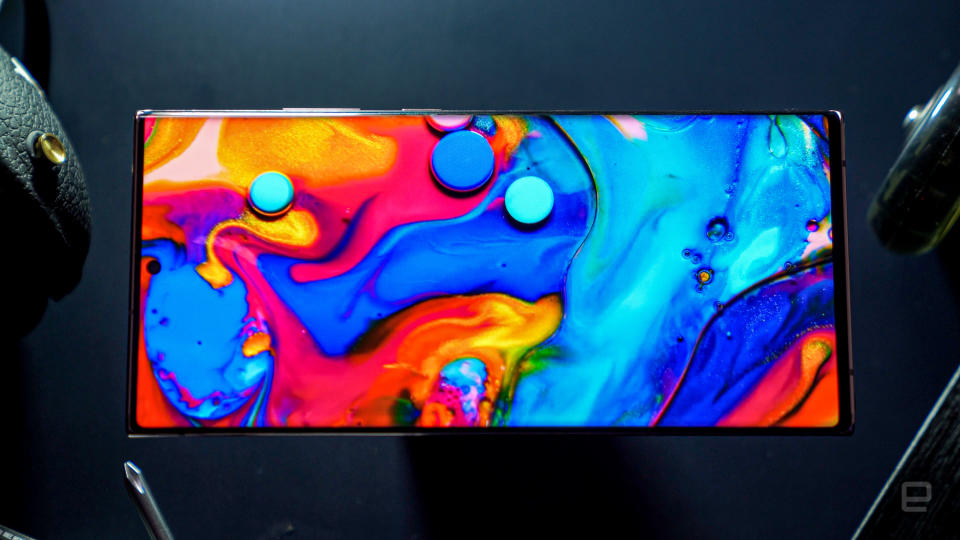
So, yes, the Note 20 Ultra will probably peek conspicuously out of your pocket. Samsung made up for this by giving the Ultra one of the nicest screens I've ever seen on a smartphone. This HDR10+ certified display produces deep blacks and vivid colors right out of the box, but persnickety types can dive into the settings and tune the screen’s color temperature just the way they like it. Most people won't need to bother, though — there's a decent chance this will be the nicest screen in your home. It certainly is in mine.
You can also dial this display up to a maximum resolution of 3088x1440, but there's still plenty of detail to be found when left running at the default 2316x1080. I'm all for choice, but you'll probably want to leave the phone at the default resolution since it can ramp its refresh rate up to 120Hz when needed. Emphasis on "when needed." Rather than keep it cranked all the time and risk burning through the battery, the Note 20 Ultra uses a new display backplane that can dynamically change the refresh rate depending on what you're doing. If you’re playing a supported game or swiping through your recent apps? Expect the full, buttery smooth 120Hz experience. If you’re reading, though, or reviewing individual photos, the refresh rate can dip as low as 10Hz, which Samsung claims can lead to significant power savings. In other words, this screen is as clever as it is pretty.
For the most part, Samsung didn't stray far from the design it ran with last year. The Note 20 Ultra's body is more squarish than the S20, which makes it feel like a proper notepad. The headphone jack remains MIA, as does the oft-maligned Bixby key — not a surprise since Samsung hardly talks about its flop of a voice assistant anymore. The phone is rated IP68 for water and dust resistance, and the screen is swathed in durable Gorilla Glass. (This year, it's Gorilla Glass Victus.) But that's not to suggest Samsung cooked up a new colorway and called it a day. For one, the Note 20 Ultra now has a sort of frosted glass black that prevents it from easily collecting grime and greasy fingerprints. And then there's that hump.
Samsung more-or-less transplanted the S20 Ultra's hefty rear camera system into the Note 20 Ultra, which means both phones have too-big humps high on their backs. The only downside to Samsung trimming a few fractions of a millimeter from the Note 20 Ultra’s waist is that the hump here is even bigger than last time. It doesn’t get in the way while you’re holding the phone or anything, but it does mean this phone tends to clatter obnoxiously when you lay it down on a table. This camera isn't just a divisive design flourish either — it's also a big liability. Every time I review a phone, I prop it up on a table for photos, and all of them have tipped over at least once. Normally, that's not such a big deal, but when the Note 20 Ultra flopped over hard onto my desk, the Gorilla Glass 6 covering the three rear cameras cracked instantly.
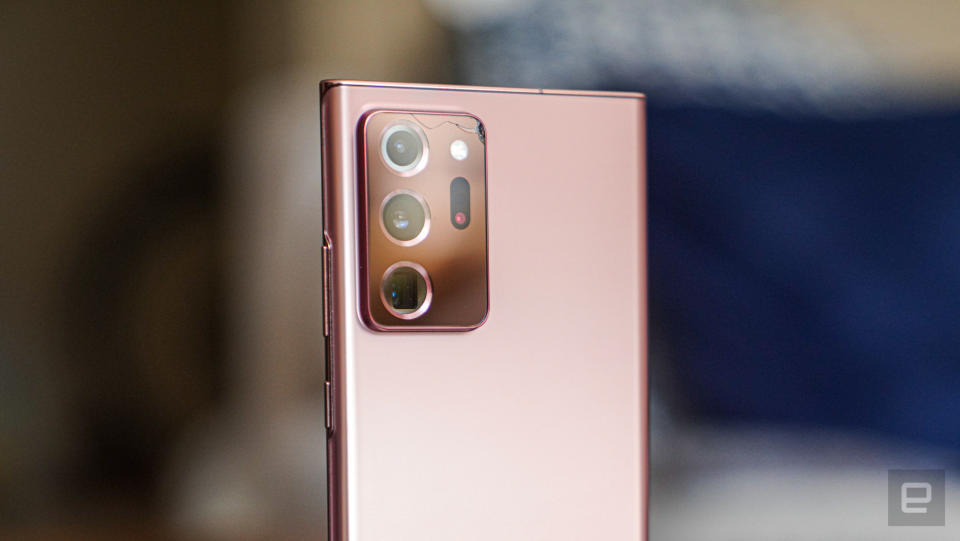
Granted, we're talking about a tiny gouge and a hairline fracture, and didn’t seem to affect camera performance at all. Still, I shudder to think what would've happened had the Note taken a spill onto concrete or asphalt. You may hate to cover up this phone's sleek finish, but trust me — between this and the instability you’ll notice when it’s on a table, the Note 20 Ultra almost requires a case.
The placement of that camera meant Samsung couldn't leave the S Pen slot on the bottom-right edge of the phone, so it shifted it to the bottom left. That might not sound like a huge deal, but it’s definitely going to throw long-time Note users for a loop. Even after a week, I still reach for the wrong side.
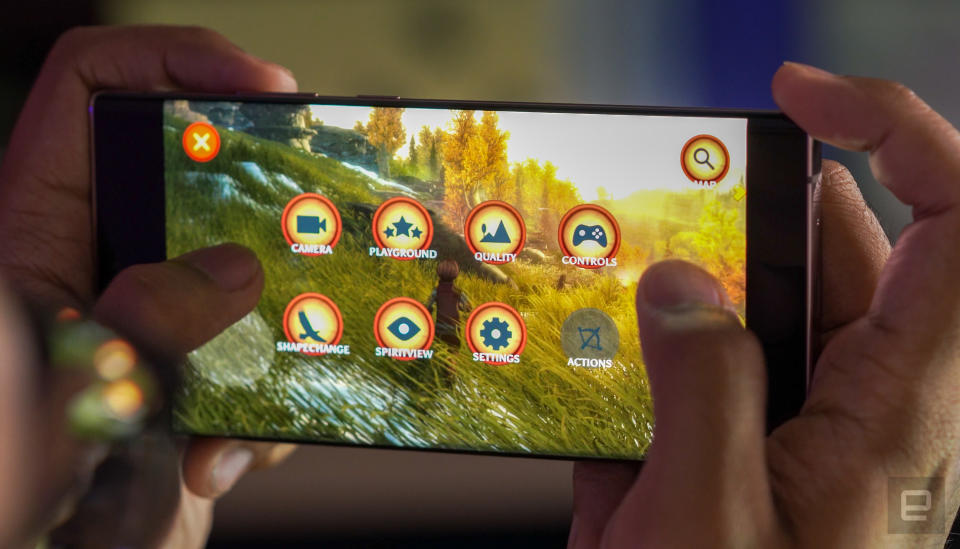
In use
In case you aren’t particularly interested in smartphone chipset nerd-talk, here are the broad strokes: The Galaxy Note 20 Ultra is the most powerful smartphone Samsung sells right now, and I can basically guarantee you that no game, no app, nothing you throw at it will give it trouble. What's more, there's enough horsepower here to keep the Note 20 Ultra feeling capable for a few years. If that's all you wanted to know, feel free to jump ahead a few paragraphs.
Still with me? OK.
It used to be that Samsung would squeeze a high-end chipset into a given year’s Galaxy S flagships, and reuse that same silicon in the Note a few months later. Things are a little different this time. All of the devices Samsung announced at its latest Unpacked event use the new, slightly faster Snapdragon 865 Plus chipset. Before you get too worked up, I should point out that the 865 Plus is basically just a binned version of the flagship chipset we’ve seen so much of this year. In this case, that means one of Qualcomm’s 865 CPU cores happened to run stably at just north of 3GHz and featured a GPU that ran slightly faster that the norm, so the company sold it as a distinct product. (And thus ends our brief, somewhat reductive detour into the fascinating world of semiconductor manufacturing.)
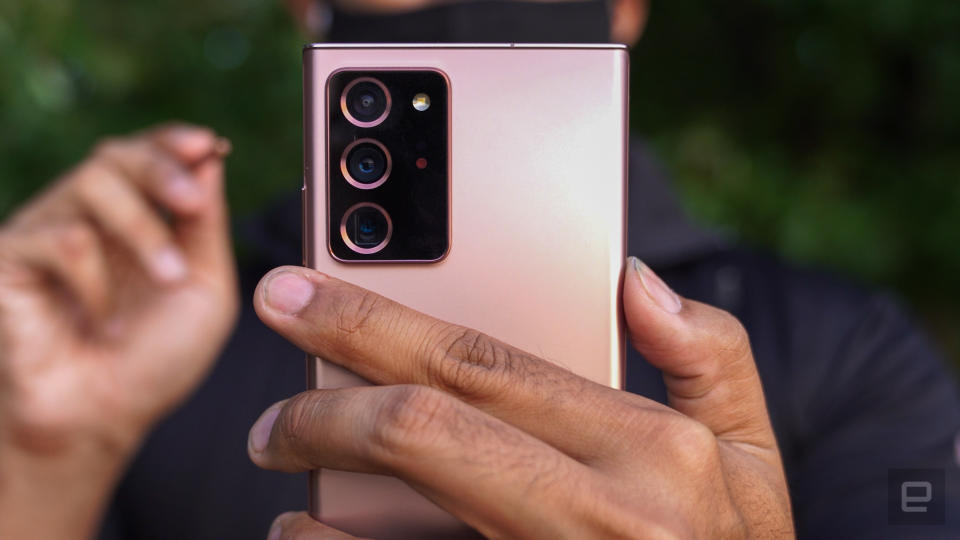
As I predicted in our not-quite-a-hands-on, the difference in performance between the Note 20 Ultra and devices using the regular Snapdragon 865 is... pretty subtle. In fact, unless you’re sifting through benchmark test results, you’d be unlikely to spot the difference in day-to-day use. That’s mostly because the "standard" 865 was already more than fast enough for most people. What the Note 20 Ultra really offers here is a little more performance headroom to grow into as Android and apps and machine learning models get more complex.
Speaking of, Samsung’s high-powered hardware keeps all of the company's add-on software (and there is plenty of it here) from bogging down the standard Android 10 experience. The company’s approach to software hasn't changed since we reviewed the Galaxy S20 Ultra, but in case you haven’t tried a Samsung phone in a while, the OneUI interface has gotten steadily better and cleaner over time. But that's not to say all of Samsung's custom software additions work the way they should.
The default Samsung keyboard sometimes failed to load when I tapped on a text field, which made sending emails and messages difficult. And Samsung Daily — a sort of Google Feed knockoff that lives to the left of your home screen — always has at least one big, animated ad in it. Samsung, you're already charging people $1,300 for this phone. Can you knock it off, please?
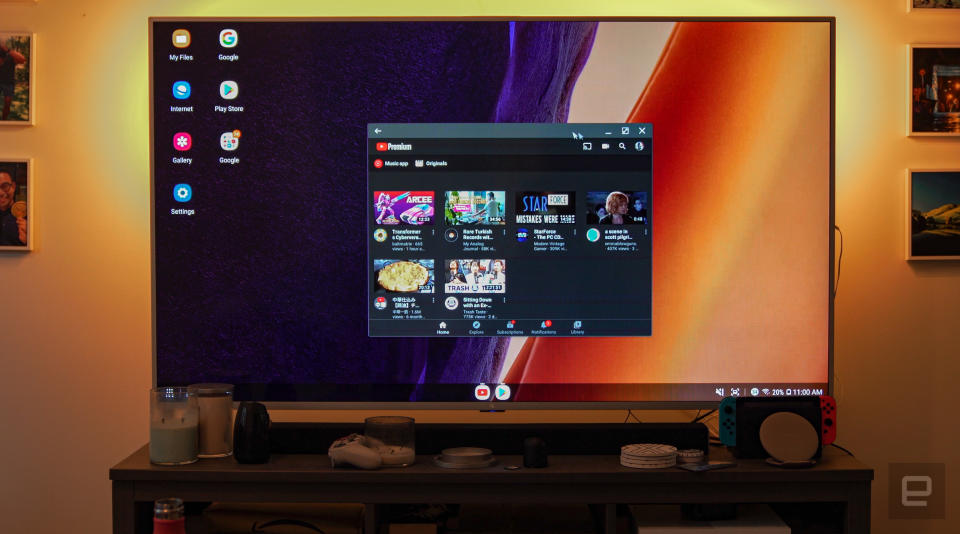
My experience with Samsung’s wireless DeX didn’t inspire much confidence either. For the uninitiated, Samsung built DeX a few years ago as a way to turn some of its most powerful smartphones into ersatz PCs. Just attach an external display, hook up some peripherals, and you had what at least looked like a proper desktop experience. And for the first time since DeX was made available three years ago, Samsung finally made the feature work without wires.
You can basically “cast” that desktop interface to any Miracast-enabled display, but it apparently works best with Samsung Smart TVs from 2019 or later. I didn't have either of those, so I did the next best thing: I bought a cheapo Miracast HDMI dongle from Amazon, connected it to my TV and prayed for the best. Setup was dead-simple and I got a proper desktop on my TV in just a few moments, but interacting with it — well, it wasn’t great. You can use the Note 20 Ultra as a trackpad, but there was so much latency that I never felt I was in direct control of the cursor. And while a Bluetooth keyboard connected to the Note 20 Ultra worked correctly with DeX, the input lag made the whole thing too frustrating to stick with. The idea of having a PC-like experience without wires is pretty amazing, but with this kind of setup at least, I don't think I'd ever bother. Maybe you people with nicer TVs will have more luck.
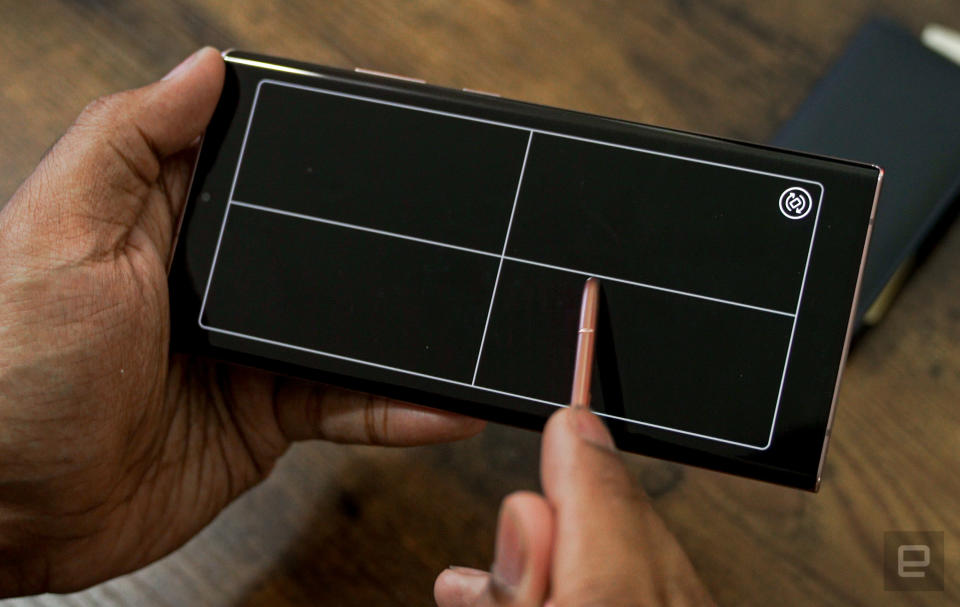
Samsung's focus on speed continues with the Note 20 Ultra's 5G support, which at this point is more a future-proofing measure than anything else. Take my corner of Brooklyn, for example: None of the nation's growing 5G networks perform particularly well here, and that’s probably true of your neighborhood too. Our review unit has been running on Verizon, and folks itching to tap into the carrier's super-fast mmWave 5G network will probably have some difficulty regularly achieving those ultra-fast speeds. Yes, you could download an entire season of Ozark in mere moments, but that requires finding just the right spot on just the street corner. And you can kiss that amazing connectivity goodbye when you start to wander.
Going into this review, I was most concerned about the Note 20 Ultra's battery life. After all, this is a phone with an enormous screen, an incredibly fast CPU, and a 4,500mAh battery — that's 500mAh smaller than the Galaxy S20 Ultra. Turns out I didn't need to worry so much. During days of heavy use, which includes frantic multitasking, camera testing, and lots of background processes, the Note 20 Ultra still stuck it out for well over 12 hours before needing a charge. That's with the screen set to its adaptive refresh rate mode. Samsung's clever screen tech might not give the Note 20 Ultra two-day battery life, but you can fall asleep knowing you'll probably have enough juice to get you through the following morning.
Long story short, the Note 20 Ultra compares very favorably to every other pricey Android phone out there in all the ways that matter. And to think, we haven't even gotten to the real standout stuff yet.
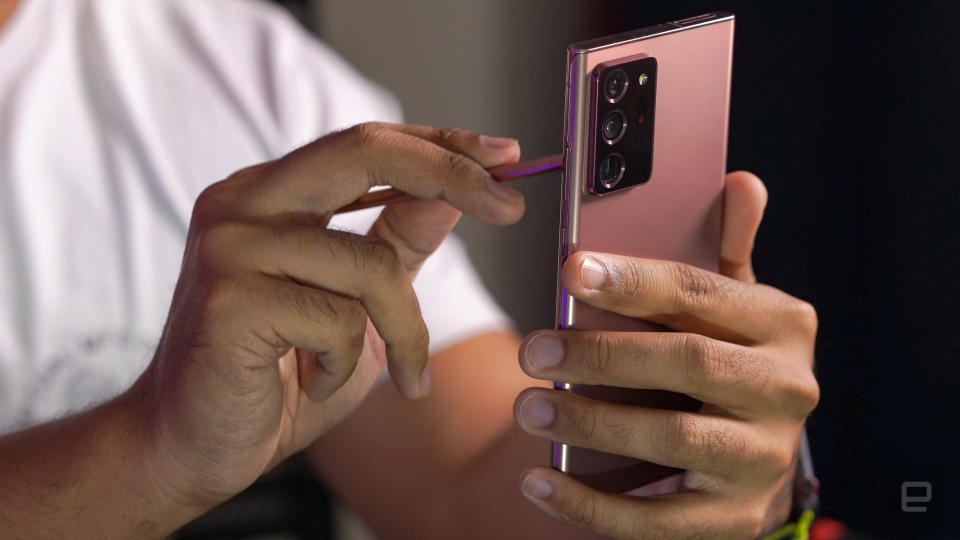
Life with the S Pen
There's no shortage of amazing Android phones you can get for less than the price of a Galaxy Note 20 Ultra. The OnePlus 8 Pro clocks in under $1,000. Sony's oddball Xperia 1 ii, with a 4K screen and the fastest smartphone camera I've ever used, goes for about $1,200. I mention this because, ultimately, Samsung is asking you to pay a premium for the S Pen.
The stylus itself hasn't actually changed since last year. It's exactly the same size and uses Bluetooth to communicate with the Note 20 Ultra when it's not close to the screen. What has changed is how quickly the Ultra responds to the S Pen. There's virtually no lag between the moment you start writing and the strokes appearing on-screen. Samsung pegs the latency at around 9ms, which makes S Pen faster than on other Notes — even the new Galaxy Note 20.
Frankly, I never had much issue with latency in earlier models, but the improvement is unmistakable. Though, you probably won’t notice unless you’re testing them side by side. What's more important here are the new and refined features Samsung built around the S Pen.
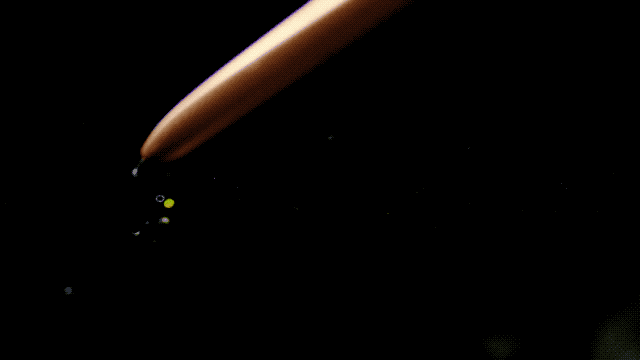
The biggest change comes in the form of "Anywhere Actions". Once you whip out the S Pen, you can draw in the air like a magic wand to control the phone. That might sound familiar, and with good reason: Last year, Samsung debuted the extremely similar App Actions.
Those are all here too, but Anywhere Actions take the concept a step further. Rather than limit those Harry Potter gestures to specific apps, you can use them at any point. By default they're tied to navigation controls like opening the Recent Apps view or returning to the home screen. At first, this all seemed a little pointless since a quick tap or swipe on the screen performed the same tasks with less fuss. But then I realized that you could map different actions and shortcuts to those gestures instead, and everything changed.
It took a little trial and error to figure out what actions and apps I wanted the quickest access to, but assigning them to gestures was dead-simple. What’s not as easy is actually getting the Note to recognize the gestures. They're all simple symbols, but even after a week, the phone can't reliably tell the difference between the right-to-left that's supposed to launch Chrome and the up-then-down that should open Gmail. When these Anywhere Actions work, they’re reasonably valuable. When they didn't, I wanted to flick the S Pen across the room.
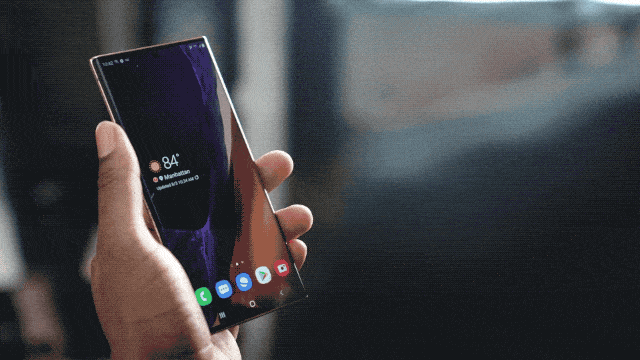
You can also use the Samsung Notes app to record audio while you jot down notes, and trust me — the feature is a lot more useful than it sounds. While the controls take some getting used to, the ability to tap a word you scrawled and hear what prompted you to write it in the first place is fantastic. It's a great option for students and note-takers who sit through meandering meetings. Though, I can't help but feel this feature would feel more useful on something like the Galaxy Tab S7 instead.
The rest of Samsung's S Pen-centric additions are either much-needed tweaks or features that are so obvious you have to wonder why they're only showing up now. Among the most helpful? The ability to import PDFs into the Samsung Notes app and mark them up with the S Pen. You can also automatically straighten slanted writing with the tap of a button, and a new Live Sync feature means edits you make with the S Pen on the Note are automatically pushed across other tablets and PCs running the Samsung Notes app.
Not of all these additions may seem thrilling, and those Anywhere Actions definitely need some fine-tuning. But when you consider how good the S Pen and the features that rely on it already were, the bits that do work well here start to seem like icing on the cake. Of course, the flip side of that argument is also true: If you never saw much value in the S Pen, I'm not sure anything Samsung added this time around will change your mind.
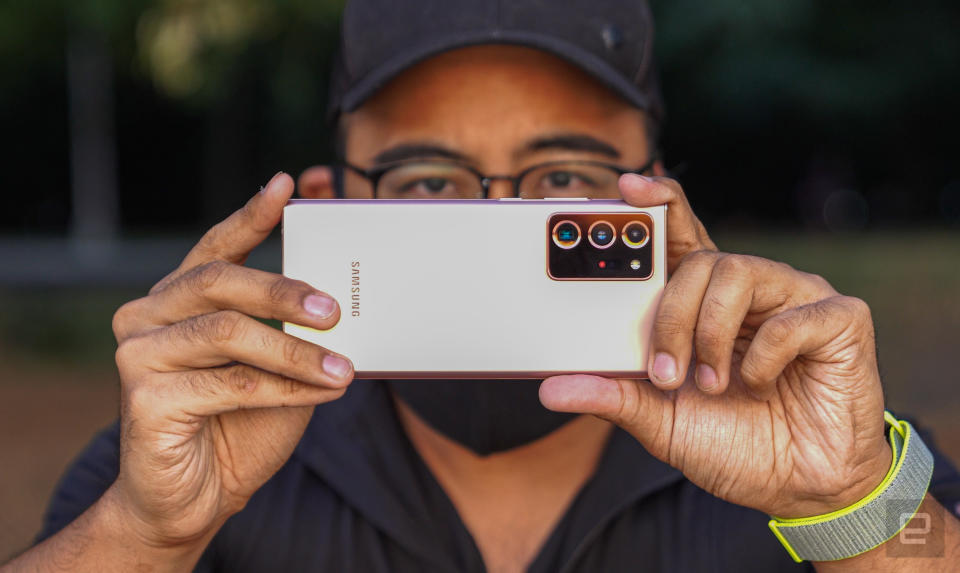
Mostly refined cameras
Since the Note 20 Ultra shares quite a few components with the Galaxy S20 Ultra, it shouldn't come as a surprise that Samsung went with a very familiar camera setup here. Here's what you'll find in that huge camera hump around back:
A 12-megapixel ultra-wide camera that captures a 120-degree field of view. This is the same sensor you'll find in the S20 Ultra, and it does a great job capturing sweeping vistas even in limited light thanks to its f/2.2 aperture.
A 108-megapixel wide camera with phase detection autofocus, optical image stabilization, and an f/1.8 aperture. This is yet another carryover from the S20 Ultra and Samsung's highest resolution camera sensor to date. Note that while you can shoot at the full 108-megapixel resolution, the camera is set to treat nine pixels on the sensor as one big one, resulting in some gorgeous 12-megapixel photos.
A 12-megapixel telephoto camera with an f/3.0 aperture. This is one of the biggest departures from the S20 Ultra, which used a 48-megapixel telephoto sensor. This isn't without its advantages: The Note 20 Ultra's telephoto camera has a slightly longer 5x optical zoom range, compared to the 4x on the S20 Ultra. (Samsung likes to tout that the S20 Ultra has "lossless" 10x hybrid optical zoom, but that's not really the same thing.) You can also Space Zoom up to 50x if you really want, though, eh. Maybe just hold off.
A laser autofocus system. When we tested the S20 Ultra, it was almost laughably bad at locking into subjects, particularly in low light. (In fairness, some of the cameras' issues were ironed out post-launch.) Rather than risk another misstep, Samsung ditched the S20 Ultra's depth sensor in favor of this dedicated autofocus module.

Samsung might not have been as ambitious with the camera setup, but that's fine. This more measured approach feels like a step in the right direction. You'll spend most of your time shooting with that 108-megapixel camera and it's the strongest performer of the bunch. Plenty (though not all) photos I shot came through with gorgeous colors and solid levels of detail. I usually default to using an iPhone 11 Pro Max as my camera of choice, but I have to hand it to Samsung — photos I shot with the Note 20 Ultra often had a more pleasant dynamic range, especially outdoors. That said, the Pixel 4’s spot-on image processing still manages to give Samsung’s main camera a run for its money.
Low-light performance has been surprisingly good here, too, especially now that there's a dedicated autofocus system. The labored hunting we saw on the S20 Ultra was downright embarrassing at times, but that’s thankfully no longer an issue here. It’s also worth noting that Samsung's scene optimizer is very good at switching to Night mode when appropriate. Some reviewers mentioned having to wait upwards of ten seconds to shoot a proper night-time photo with the S20 Ultra, but with the Note 20 Ultra, the same process never took more than five.

Since this is Samsung we're talking about, we need to talk more about image processing. As I've said before, the company's cameras have a strong tendency to capture an idealized version of reality instead of what's actually in front of it. Blue skies are bluer, fields are greener, people's faces are brighter and smoother — I'm sure Samsung would say that last thing is a kindness, but the results often just aren’t in lockstep with the real scene. And in an attempt to give photos more clarity, fine details are sometimes amplified to the point where actually look hazy and indistinct. These are long-time criticisms of Samsung's cameras, and at this point, I have to wonder if the company has any real interest in addressing them. Maybe this is just the “Samsung look,” and we’ll all just have to accept it.
In any case, the main camera is a solid all-around player, and nothing if not technically impressive. Here’s my big issue, though I never felt like I was consistently getting the best out of it. For every beautifully rendered photo outdoor photo, there's a flat, unappealing food pic. For every correctly exposed night shot, there's a muddy mess because the scene optimizer didn't kick in. Sometimes it blows the iPhone 11 Pro out of the water. Other times it falls way short. More often than not, the Note 20 Ultra produces the sort of eye-catching images you want to see — just be prepared for the occasional disappointment.
Meanwhile, the ultra-wide and telephoto cameras play their specialized roles nicely. I'm not much of a landscape person, but I found myself enjoying the ultra-wide a lot more than I thought I would. Samsung has done an impressive job bringing its overall image quality closer to that of the main camera, and it often exposes scenes more accurately than the iPhone 11 Pro Max. The Note 20 Ultra's telephoto camera turned out to be a pleasant surprise, too. Samsung went with a lower resolution sensor, but 5x really feels like the sweet spot: It gives me plenty of range without having to find a different vantage point. And pushing a little past that 5x into the realm of digital zoom produces passable results until you hit about 10x or so.
Anything beyond that begins to put you in Space Zoom territory, which works about as well as it did when it debuted on the S20 Ultra. Well, fine — it actually works slightly better here, because Samsung’s choice of telephoto camera effectively took the 100x zoom feature off the table. Good riddance, I say: The 50x zoom available here is still complete overkill in most scenarios, and framing up a far-off subject is just as difficult as ever. And then there’s the fact that the resulting images will look more like oil paintings than photographs. Honestly, I can count on one hand the number of times I shot a 50x photo and felt great about it — this is still just a "look what we can do!" feature.

Meanwhile, the 10-megapixel front-facing camera isn't much to write home about — it offers reasonably detail and clarity, though that stuff drops off fast when lighting is anything but ideal. Like the main rear camera, this thing also often brightens up people's faces in a way that just feels incorrect. I know I've mostly been stuck inside for the last five months, but I know I'm not as pale as this camera thinks I am.
The few other camera improvements you'll find here mostly have to do with the camera. Samsung's Pro Video mode, which lets you shoot at resolutions as high as 8K, now has controls for tweaking your zoom speed. Strange, I know, but it's a neat way to add a bit of cinematic flair to your next smartphone film project. The footage captured in this mode is as slick as ever, though you'd still be hard-pressed to tell in most cases since 8K displays are still pretty uncommon. Oh, and if you have a pair of Galaxy Buds Live, you could use them as makeshift lavalier mics — as someone who has to deal with microphones for video frequently, I was looking forward to trying this out, but that'll have to wait until I nab some of those sweet beans.

What comes next?
I've been using what Samsung assures us is the final, retail-ready software for the Note 20 Ultra, and it's a hell of a lot more stable than the S20 Ultra was during our review. That said, some of the Note 20 Ultra's features either aren't ready yet or require hardware that's hard to come by.
Take Link to Windows for instance: it works well, and in addition to passing messages and notifications over to your PC, you can mirror and manipulate the Note 20 Ultra's display on your desktop. I haven't found much use for it besides keeping a dedicated Instagram app within range of a mouse click, but it will eventually gain the ability to run up to six apps, each in their own window. Maybe that extra flexibility will make it more valuable, but we'll just have to see.
Since I only have one Note 20 Ultra, I haven't been able to test its ultra-sideband (or UWB) Nearby Share feature yet. Conceptually, it's a lot like AirDrop in that you can point one UWB-enabled device at another to forge a connection, and quickly shoot files over. For now, though, the Note 20 Ultra is the only thing Samsung sells with a UWB radio, so it'll be a while before this feature makes sense for most people. And bear in mind, that's just the beginning of what's possible with UWB. Samsung has already said it's partnering with carmakers and security companies so users can unlock doors and start their cars without whipping out their keys.
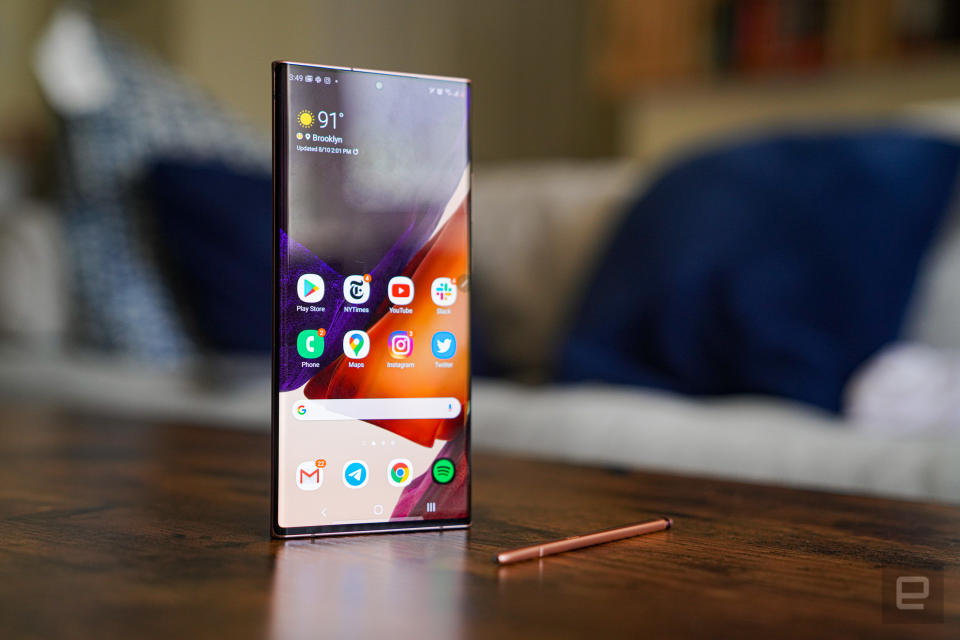
Wrap-up
The Galaxy Note was never for everyone, and it still isn't. Wacky promotions notwithstanding though, the Note 20 Ultra is a better deal than the Galaxy S20 Ultra, so I'm happy to call it the crown jewel of Samsung's non-foldable smartphone line-up. Just remember: It still costs $300 more than a slew of other excellent, high-end devices. If you want a tried-and-true Samsung phone that doesn't overdo the gimmicks, buy a Galaxy S20. If you just want speed, buy a OnePlus 8 Pro. But if you think your life could be made even a little more convenient or fruitful by carrying a tiny, smart pen around with you, the Note 20 Ultra is absolutely worth a shot.

